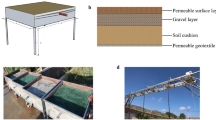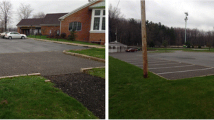Abstract
Porous asphalt (PA), porous concrete (PC), and permeable inter-locking pavers (PICP) with sub-surface layers consisting of different gravel sizes (63, 40, and 12 mm) commonly used in the bedding, base, and sub-base layers of permeable pavements were investigated for their ability to remove total suspended solids (TSS), total phosphorous (TP), and total nitrogen (TN). The investigation focused on the individual surface and sub-surface layers of the three permeable pavements to “treat” these pollutants and how the physical design of these layers influences their water quality treatment performance. This assessment was conducted with a laboratory study, but performances were also compared to data obtained from a field-scale study of pollutant removal in PA, PC, and PICP. Pollutant removal by a sub-surface layer and the particle size distribution of outflow are dependent on both the thickness of the layer and the gravel size. Superior performance in removing pollutants was found in PC’s surface layer compared to the surface layers of PA and PICP. The lab-scale pavements and the field-scale pavements have similar performance in removing pollutants for TSS (87–95 %) and TP (75–89 %) but not for TN (3–10 % for lab-scale and 2–40 % for field-scale pavements). A simple mathematical model based on these results was developed to provide estimates of performance in the field.











Similar content being viewed by others
References
Ahiablame, L. M., Engel, B. A., & Chaubey, I. (2012). Effectiveness of low impact development practices: literature review and suggestions for future research. Water, Air, and Soil Pollution, 223(7), 4253–4273.
Al-Rawas, G., Valeo, C., Khan, U., & Al-Hafeedh, O. (2015). Effects of urban form on wadi flow frequency analysis in the Wadi Aday watershed in Muscat, Oman. Urban Water Journal, 12(4), 263–274. doi:10.1080/1573062X.2013.857420.
Andral, M. C., Roger, S., Montrejaud-Vignoles, M., & Herremans, L. (1999). Particle size distribution and hydrodynamic characteristics of solid matter carried by runoff from motorways. Water Environment Research, 71(4), 398–407.
APHA. (1998). Standard methods for the examination of water and wastewater (20th ed.). Washington: Published jointly by the American Public Health Association, American Water Works Association, and Water Environment Federation.
Balades, J., Legret, M., & Madiec, H. (1995). Permeable pavements: pollution management tools. Water Science and Technology, 32(1), 49–56.
Ball, J., & Rankin, K. (2010). The hydrological performance of a permeable pavement. Urban Water Journal, 7(2), 79–90.
Barnes, K. B., Morgan, J., & Roberge, M. (2001). Impervious surfaces and the quality of natural and built environments. Baltimore: Department of Geography and Environmental Planning, Towson University.
Bean, E. Z., 2005. A field study to evaluate permeable pavement surface infiltration rates, runoff quantity, runoff quality, and exfiltrate quality. Thesis (MSc). North Carolina State University, Raleigh, USA.
Bean, E. Z., Hunt, W. F., & Bidelspach, D. A. (2007). Evaluation of four permeable pavement sites in eastern North Carolina for runoff reduction and water quality impacts. Journal of Irrigation and Drainage Engineering, 133(6), 583–592.
Bentarzi, Y., Ghenaim, A., Terfous, A., Wanko, A., Feugeas, F., Poulet, J. B., and Mosé, R. (2015). Hydrodynamic behaviour of a new permeable pavement material under high rainfall conditions. Urban Water Journal, 1-10
Booth, D. B., & Leavitt, J. (1999). Field evaluation of permeable pavement systems for improved stormwater management. Journal of the American Planning Association, 65(3), 314–325.
Brown, C., 2007. Characterization of solids removal and clogging processes in two types of permeable pavement. Thesis (MSc). University of Calgary, Calgary, Canada
Brown, C., Chu, A., Van Duin, B., & Valeo, C. (2009). Characteristics of sediment removal in two types of permeable pavement. Water Quality Research Journal of Canada, 44(1), 59–70.
Collins, K. A., Hunt, W. F., & Hathaway, J. M. (2009). Side-by-side comparison of nitrogen species removal for four types of permeable pavement and standard asphalt in eastern North Carolina. Journal of Hydrologic Engineering, 15(6), 512–521.
Davies, J. W., Pratt, C. J., and Scott, M. A. (2002). Laboratory study of permeable pavement systems to support hydraulic modeling. In Global Solutions for Urban Drainage (pp. 1–9). doi:10.1061/40644(2002)34.
Dietz, M. E. (2007). Low impact development practices: a review of current research and recommendations for future directions. Water, Air, and Soil Pollution, 186(1-4), 351–363.
Dreelin, E. A., Fowler, L., & Ronald Carroll, C. (2006). A test of porous pavement effectiveness on clay soils during natural storm events. Water Research, 40(4), 799–805.
Eck, B. J., Winston, R. J., Hunt, W. F., & Barrett, M. E. (2011). Water quality of drainage from permeable friction course. Journal of Environmental Engineering, 138(2), 174–181.
Ellis, J. B., Revitt, D. M., & Lundy, L. (2012). An impact assessment methodology for urban surface runoff quality following best practice treatment. The Science of the Total Environment, 416, 172–179.
Fach, S., & Geiger, W. (2005). Effective pollutant retention capacity of permeable pavements for infiltrated road runoffs determined by laboratory. Water Science and Technology, 51(2), 37–46.
Ferguson, B. K. (2005). Porous pavement. Boca Raton: CRC Press.
Finkenbine, J., Atwater, J., & Mavinic, D. (2000). Stream health after urbanization. Journal of the American Water Resources Association, 36(5), 1149–1160.
Gerrits, C., 2001. Restoration of infiltration capacity of permeable pavers. Thesis (MSc). University of Guelph, Guelph, Canada
Gilbert, J. K., & Clausen, J. C. (2006). Stormwater runoff quality and quantity from asphalt, paver, and crushed stone driveways in Connecticut. Water Research, 40(4), 826–832.
Hatt, B. E., Fletcher, T. D., & Deletic, A. (2007). Treatment performance of gravel filter media: implications for design and application of stormwater infiltration systems. Water Research, 41(12), 2513–2524.
Huang, J., Valeo, C., He, J., & Chu, A. (2012). Winter performance of inter-locking pavers—stormwater quantity and quality. Water, 4(4), 995–1008.
Huang, J., Valeo, C., He, J., and Chu, A., 2015. Three types of permeable pavements in cold climates: hydraulic and environmental performance. J. Environ. Eng., in press.
Kayhanian, M., McKenzie, E., Leatherbarrow, J., & Young, T. (2012). Characteristics of road sediment fractionated particles captured from paved surfaces, surface run-off and detention basins. The Science of the Total Environment, 439, 172–186.
Kuba, T., Smolders, G., Van Loosdrecht, M., & Heijnen, J. (1993). Biological phosphorus removal from wastewater by anaerobic-anoxic sequencing batch reactor. Water Science and Technology, 27(5-6), 241–252.
Newman, A., Pratt, C., Coupe, S., & Cresswell, N. (2002). Oil bio-degradation in permeable pavements by microbial communities. Water Science and Technology, 45(7), 51–56.
Pagotto, C., Legret, M., & Le Cloirec, P. (2000). Comparison of the hydraulic behaviour and the quality of highway runoff water according to the type of pavement. Water Research, 34(18), 4446–4454.
Palla, A., Gnecco, I., Carbone, M., Garofalo, G., Lanza, L. G., & Piro, P. (2015). Influence of stratigraphy and slope on the drainage capacity of permeable pavements: laboratory results. Urban Water Journal, 12(5), 394–403.
Pennsylvania Department of Environmental Protection (2006). Pennsylvania stormwater best management practices manual. Bureau of Watershed Management. Document Number 363-0300-002. December 30, 2006. Pennsylvania, USA. 642 pages. Volume 34, Tab 20.
Pratt, C. (1995). A review of source control of urban stormwater runoff. Water and Environmental Management, 9(2), 132–139.
Pratt, C., Mantle, J., & Schofield, P. (1995). UK research into the performance of permeable pavement, reservoir structures in controlling stormwater discharge quantity and quality. Water Science and Technology, 32(1), 63–69.
Roger, S., Montrejaud-Vignoles, M., Andral, M. C., Herremans, L., & Fortune, J. P. (1998). Mineral physical and chemical analysis of the solid matter carried by motorway runoff water. Water Research, 32(4), 1119–1125.
Rushton, B. T. (2001). Low-impact parking lot design reduces runoff and pollutant loads. Journal of Water Resources Planning and Management, 127(3), 172–179.
Sartor, J., Boyd, G. B., & Agardy, F. J. (1974). Water pollution aspects of street surface contaminants. J Water Pollut Control Fed, 46(3), 458–465.
Scholz, M., & Grabowiecki, P. (2007). Review of permeable pavement systems. Building and Environment, 42(11), 3830–3836.
Stotz, G., & Krauth, K. (1994). The pollution of effluents from pervious pavements of an experimental highway section: first results. The Science of the Total Environment, 146, 465–470.
The City of Calgary. (2011). Stormwater management and design manual. Canada: Calgary.
Tota-Maharaj, K., & Scholz, M. (2010). Efficiency of permeable pavement systems for the removal of urban runoff pollutants under varying environmental conditions. Environmental Progress & Sustainable Energy, 29(3), 358–369.
Tuccillo, M. E. (2006). Size fractionation of metals in runoff from residential and highway storm sewers. The Science of the Total Environment, 355, 288–300.
Watanabe, S. (1995). Study on storm water control by permeable pavement and infiltration pipes. Water Science and Technology, 32(1), 25–32.
Wiesmann, U. (1994). Biological nitrogen removal from wastewater. Adv Biochem Eng Biotechnol, 51, 113–154.
Acknowledgments
The authors would like to thank the Natural Sciences and Engineering Research Council of Canada, the City of Calgary, and Urban Systems in Calgary for their financial support to the research. Additionally, the authors thank Daniel Larson, Don Anson, and Terry Quinn of Civil Engineering at the University of Calgary for assistance with the experiments. Further thanks are extended to Lafarge and UNI-GROUP U.S.A. for the donation of test materials.
Author information
Authors and Affiliations
Corresponding author
Rights and permissions
About this article
Cite this article
Huang, J., Valeo, C., He, J. et al. The Influence of Design Parameters on Stormwater Pollutant Removal in Permeable Pavements. Water Air Soil Pollut 227, 311 (2016). https://doi.org/10.1007/s11270-016-3020-y
Received:
Accepted:
Published:
DOI: https://doi.org/10.1007/s11270-016-3020-y




